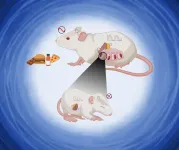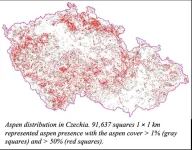(Press-News.org) EMBARGOED FOR RELEASE UNTIL 4 P.M. ET, WEDNESDAY, MARCH 27, 2024
MINNEAPOLIS – Artificial intelligence (AI) may serve as a future tool for neurologists to help locate where in the brain a stroke occurred. In a new study, AI processed text from health histories and neurologic examinations to locate lesions in the brain. The study, which looked specifically at the large language model called generative pre-trained transformer 4 (GPT-4), is published in the March 27, 2024, online issue of Neurology® Clinical Practice, an official journal of the American Academy of Neurology.
A stroke can cause long-term disability or even death. Knowing where a stroke has occurred in the brain helps predict long-term effects such as problems with speech and language or a person’s ability to move part of their body. It can also help determine the best treatment and a person’s overall prognosis.
Damage to the brain tissue from a stroke is called a lesion. A neurologic exam can help locate lesions, when paired with a review of a person’s health history. The exam involves symptom evaluation and thinking and memory tests. People with stroke often have brain scans to locate lesions.
“Not everyone with stroke has access to brain scans or neurologists, so we wanted to determine whether GPT-4 could accurately locate brain lesions after stroke based on a person’s health history and a neurologic exam,” said study author Jung-Hyun Lee, MD, of State University of New York (SUNY) Downstate Health Sciences University in Brooklyn and a member of the American Academy of Neurology.
The study used 46 published cases of people who had stroke. Researchers gathered text from participants’ health histories and neurologic exams. The raw text was fed into GPT-4. Researchers asked it to answer three questions: whether a participant had one or more lesions; on which side of the brain lesions were located; and in which region of the brain the lesions were found. They repeated these questions for each participant three times. Results from GPT-4 were then compared to brain scans for each participant.
Researchers found that GPT-4 processed the text from the health histories and neurologic exams to locate lesions in many participants’ brains, identifying which side of the brain the lesion was on, as well as the specific brain region, with the exception of lesions in the cerebellum and spinal cord.
For the majority of people, GPT-4 was able to identify on which side of the brain lesions were found with a sensitivity of 74% and a specificity of 87%. Sensitivity is the percentage of actual positives that are correctly identified as positive. Specificity is the percentage of negatives that are correctly identified. It also identified the brain region with a sensitivity of 85% and a specificity of 94%.
When looking at how often the three tests had the same result for each participant, GPT-4 was consistent for 76% of participants regarding the number of brain lesions. It was consistent for 83% of participants for the side of the brain, and for 87% of participants regarding the brain regions.
However, when combining its responses to all three questions across all three times, GPT-4 provided accurate answers for 41% of participants.
“While not yet ready for use in the clinic, large language models such as generative pre-trained transformers have the potential not only to assist in locating lesions after stroke, they may also reduce health care disparities because they can function across different languages,” said Lee. “The potential for use is encouraging, especially due to the great need for improved health care in underserved areas across multiple countries where access to neurologic care is limited.”
A limitation of the study is that the accuracy of GPT-4 depends on the quality of the information it is provided. While researchers had detailed health histories and neurologic exam information for each participant, such information is not always available for everyone who has a stroke.
Learn more about stroke at BrainandLife.org, home of the American Academy of Neurology’s free patient and caregiver magazine focused on the intersection of neurologic disease and brain health. Follow Brain & Life® on Facebook, X and Instagram.
When posting to social media channels about this research, we encourage you to use the hashtags #Neurology and #AANscience.
The American Academy of Neurology is the world's largest association of neurologists and neuroscience professionals, with over 40,000 members. The AAN’s mission is to enhance member career fulfillment and promote brain health for all. A neurologist is a doctor with specialized training in diagnosing, treating and managing disorders of the brain and nervous system such as Alzheimer's disease, stroke, concussion, epilepsy, Parkinson's disease, multiple sclerosis, headache and migraine.
For more information about the American Academy of Neurology, visit AAN.com or find us on Facebook, X, Instagram, LinkedIn and YouTube.
END
Could AI play a role in locating damage to the brain after stroke?
2024-03-27
ELSE PRESS RELEASES FROM THIS DATE:
High fat/low protein diets in rats during pregnancy and postnatally may cause altered glucose control and other "maladaptive" metabolic changes in their offspring
2024-03-27
High fat/low protein diets in rats during pregnancy and postnatally may cause altered glucose control and other "maladaptive" metabolic changes in their offspring
###
Article URL: https://journals.plos.org/plosone/article?id=10.1371/journal.pone.0299554
Article Title: Intrauterine and early-life malnutrition in rats disrupts the circadian rhythm programming of energy metabolites through adulthood
Author Countries: México
Funding: This research was partially supported by PD-LBAE-FC UNAM 2015-2019, DGAPA ...
Just 1 in 14 adults across 55 LMICs who have both hypertension and diabetes have both conditions under adequate control
2024-03-27
Just 1 in 14 adults across 55 LMICs who have both hypertension and diabetes have both conditions under adequate control, with only 20-30% of patients taking medications, indicating a lack of adequate healthcare in these settings.
======
Article URL: https://journals.plos.org/globalpublichealth/article?id=10.1371/journal.pgph.0003019
Article Title: Multiple cardiovascular risk factor care in 55 low- and middle-income countries: A cross-sectional analysis of nationally-representative, individual-level data from 280,783 adults
Author Countries: ...
Your emotional reaction to climate change may impact the policies you support
2024-03-27
Emotional reactions to climate change may lead to specific policy preferences, according to a study published March 27, 2024 in the open-access journal PLOS Climate by Teresa A. Myers of George Mason University and colleagues.
A politician, public speaker, or journalist may opt for an emotional appeal when communicating about climate change. Indeed, research shows that emotional investment can raise awareness of important issues and galvanize an otherwise apathetic public. However, existing research has not explored the unique links between specific ...
Persistent hiccups in a far-off galaxy draw astronomers to new black hole behavior
2024-03-27
At the heart of a far-off galaxy, a supermassive black hole appears to have had a case of the hiccups.
Astronomers from MIT, Italy, the Czech Republic, and elsewhere have found that a previously quiet black hole, which sits at the center of a galaxy about 800 million light years away, has suddenly erupted, giving off plumes of gas every 8.5 days before settling back to its normal, quiet state.
The periodic hiccups are a new behavior that has not been observed in black ...
Europe’s forgotten forests could be 21st century ‘biodiversity hot spots’
2024-03-27
An overlooked and long-neglected type of forest has vast capacity to rebound, enhancing species diversity and resilience to climate change, according to an international team of forest scientists.
According to new research, published today in the peer-reviewed science journal PLOS ONE, there is ample habitat for the Eurasian aspen, and these environments will continue to be suitable for this “keystone species” as the global climate warms.
“The Eurasian aspen, and aspen species globally, are home to vast populations of other dependent plants and animals,” said the study’s lead author, Antonin Kusbach, an applied ecologist at Mendel University in ...
Combining epigenetic cancer medications may have benefit for colorectal cancers and other tumor types
2024-03-27
GRAND RAPIDS, Mich. (March 27, 2024) — A pair of medications that make malignant cells act as if they have a virus could hold new promise for treating colorectal cancers and other solid tumors, reports a study published today in Science Advances.
The preclinical research, led by Van Andel Institute scientists, determined how low doses of a DNMT inhibitor sensitize cancer cells to an EZH2 inhibitor, resulting in a one-two punch that combats cancer cells better than either drug alone.
The findings are the foundation for an upcoming Phase I clinical trial to evaluate this combination ...
Reevaluating an approach to functional brain imaging
2024-03-27
A new way of imaging the brain with magnetic resonance imaging (MRI) does not directly detect neural activity as originally reported, according to scientists at MIT’s McGovern Institute. The method, first described in 2022, generated excitement within the neuroscience community as a potentially transformative approach. But a study from the lab of McGovern associate investigator Alan Jasanoff, reported March 27, 2024, in the journal Science Advances, demonstrates that MRI signals produced by the new method are generated in large part by the imaging process itself, ...
Food matters: Healthy diets increase the economic and physical feasibility of 1.5°C
2024-03-27
“We find that a more sustainable, flexitarian diet increases the feasibility of the Paris Agreement climate goals in different ways,” says Florian Humpenöder, PIK scientist and co-lead author of the study to be published in Science Advances. “The reduction of greenhouse gas emissions related to dietary shifts, especially methane from ruminant animals raised for their meat and milk, would allow us to extend our current global CO2 budget of 500 gigatons by 125 gigatons and still stay within the limits of 1.5°C with a 50 percent chance,” he adds.
Putting a price on greenhouse gas (GHG) emissions ...
Land under water – what causes extreme flooding
2024-03-27
There are several factors that play an important role in the development of floods: air temperature, soil moisture, snow depth, and the daily precipitation in the days before a flood. In order to better understand how individual factors contribute to flooding, UFZ researchers examined more than 3,500 river basins worldwide and analysed flood events between 1981 and 2020 for each of them. The result: precipitation was the sole determining factor in only around 25% of the almost 125,000 flood events. Soil moisture was the decisive factor in just over 10% of cases, and ...
Understanding why people sell their kidneys
2024-03-27
A systematic review of 35 years of global medical literature finds a spectrum of reasons why people sell kidneys. The study, by Bijaya Shrestha of the Center for Research on Education, Health and Social Science, Kathmandu, Nepal, finds limited efforts toward mitigating the problem as well as a lack of evidence around the impact of policy and biotechnology. It is published in the open access journal PLOS Global Public Health.
Demand for kidney donation is higher than supply, and it has become one of the most saleable human ...




